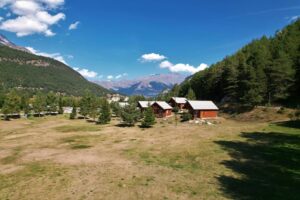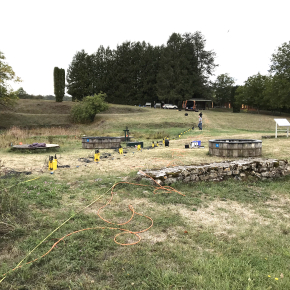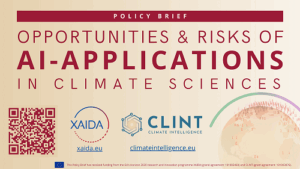SOCAT version 2021 for quantification of ocean CO2 uptake
The latest version of the international data-base SOCAT (Surface Ocean CO2 atlas, www.socat.info) has been released on June 15th 2021.
SOCAT version 2021 assembled 32 Millions of carbon dioxide sea surface observations in the global ocean, marginal seas and coastal zones. The laboratory Laboratoire d’océanographie et du climat : expérimentation et approches numériques (LOCEAN/IPSL/OSU Ecce Terra, SU/CNRS/MNHN/IRD) is involved in this project that was first discussed during an international workshop organized in Paris/UNESCO in 2007.
The ocean plays a crucial role to regulate the climate change. It absorbs more than 90% of heat excess and presently a quarter of CO2 emitted by human activities (fossil fuels and land-used changed). Since 1750, the ocean captured about 170 PgC of a total of 700 PgC anthropogenic emissions.
Without this ocean carbon sink, the CO2 concentrations in the atmosphere would be 495 ppm compared to 412.5 ppm as observed in 2020. Although there was a small decrease of the anthropogenic emissions in 2020 due to the pandemic COVID-19 (reduction of around 4-7 %), the CO2 in the atmosphere increased at a rate of +2.5 ppm in 2020, i.e. same as in the previous decade.
In this context it is important to evaluate each year the global carbon budget. For this, researchers compile the inventories of anthropogenic emissions and the atmospheric and oceanic observations needed to evaluate the air-sea CO2 exchange. The terrestrial carbon sink is evaluated from models or derived from the residual of the carbon budget between other compartments.
A direct impact of anthropogenic CO2 progressively accumulated in the oceans leads to the process called “ocean acidification” (decrease of pH). This is now relatively well observed in all oceans but the impacts of ocean acidification on marine organisms (like phytoplankton or corals) need to be improved. Consequently, and like the temperature or the sea-level, ocean pH is now recognized as one of the 7 “ocean indicators” for global change issue.
In this context it is important to maintain and integrate ocean CO2 observations from year to year in all ocean regions, including marginal seas and coastal zones where the variability of the oceanic biogeochemical properties (including CO2) is pronounced. This is the aim of the SOCAT project started in 2007 during an international workshop organized in Paris/UNESCO, a data-base regularly updated since 2011. Although several ocean cruises and projects were interrupted in 2020 (due to COVID-19) SOCAT added this year 2 Millions of new quality controlled fCO2 observations from 356 cruises, VOS lines and moorings (Figure 1).

Figure 1. Left: Map of the new sea surface CO2 fugacity (fCO2, µatm) added in the SOCAT version 2021 (mainly for the period 2018-2020). In the Atlantic and Southern Ocean one identified the sailing route of the Vendée Globe race (Sea-Explorer, skipper Boris Herrmann). Right: All data in SOCAT for the period 1957-2020. Squares identified CO2 probes on moorings. The atmospheric CO2 level in the atmosphere being around 410 ppm today, the blue-green region (resp. yellow-orange-red) identified ocean CO2 sink (resp. source). Note few observations available in recent years in the south Pacific and Indian Oceans that calls to use data-based approaches to extrapolate the fCO2 field and calculate integrated air-sea CO2 fluxes at large scale (Figure 2) or to estimate change in pH (ocean acidification) in the oceans (Figure 3). D. R.
Since the first SOCAT version published in 2011 with 6.3 million data, SOCAT includes today 32.6 million sea surface fCO2 data in the global ocean and coastal zones for the period 1957-2020. Each data available on-line is associated with a quality control information. SOCAT also offers gridded products (monthly scale) that could be used to validate ocean biogeochemical models. An interactive tool (LAS Data viewer) enables to visualize the data and download them for specific region or period. The SOCAT data-base is also available in ODV format (Ocean Data View, https://odv.awi.de/).
The annual SOCAT public release contributes to UN Sustainable Development Goals (SDG) 13 and 14 (#OceanAction20464) and to the UN Decade of Ocean Science for Sustainable Development. SOCAT has been used in more than 350 publications and international reports (www.socat.info/publications.html), in particular:
- SOCAT documents the increase in global surface ocean CO2
- Advanced interpolation schemes used SOCAT to fill data gaps in time and space
- SOCAT helps to evaluate year-to-year and decadal variation in global ocean CO2 uptake
- SOCAT is used to evaluate sensor data (BGC Argo floats, gliders, moorings) and models, including CMIP
- SOCAT informs the Global Carbon Budget (Figure 2)
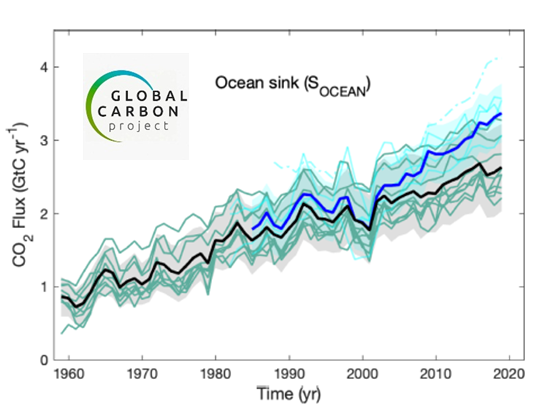
Figure 2. The global ocean carbon sink for the period 1959-2019 using ocean models (individual in green, model mean in black) or from data-based approaches using SOCAT (en cyan). Source: Global Carbon Project (Friedlingstein et al, 2020). Both models and diagnostic methods show an increase of the ocean carbon sink. Notice that observations suggest larger interannual variability not yet resolved in the models. D. R.
- SOCAT helps to quantify ocean acidification (Figure 3)
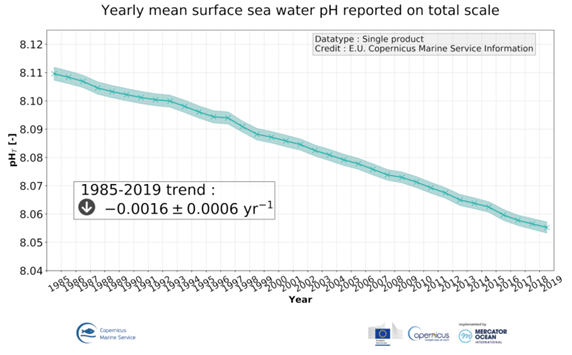
Figure 3. Long-term pH change in the global ocean reconstructed using a Neural-Network method from LSCE-IPSL based on SOCAT data (Chau et al, 2020). Over the period 1985-2019, the progressive decrease of pH informs on the so-called “Ocean acidification”. Source CMEMS (https://marine.copernicus.eu/access-data/ocean-monitoring-indicators). D. R.
The LOCEAN/IPSL laboratory feeds regularly data in SOCAT (from observatories SO/OISO, PIRATA, SSS, Boussole/Dyfamed), contributes to the data quality control for the Tropical Atlantic, Indian and Southern Ocean regional SOCAT groups. The project is coordinated by Dorothee Bakker (East Anglia University, Norwich UK). It has been supported by international programs (SOLAS, IMBER, IOCCP, ICOS), European project (Carboocean, CarboChange, Atlantos) and many national institutions.
Contact
Nicolas Metzl, LOCEAN/IPSL, 01 44 27 33 94 – 06 77 47 72 48 –
| Références
Bakker, D. C. E., Pfeil, B., Landa, C. S., Metzl, N., O’Brien, K. M., et al., 2016.: A multi-decade record of high-quality fCO2 data in version 3 of the Surface Ocean CO2 Atlas (SOCAT), Earth Syst. Sci. Data, 8, 383-413, doi:10.5194/essd-8-383-2016. Bakker, D. C. E., Alexander, B., Tjiputra, J., Ishii, M., Key, R. Landschützer, P., Lauvset, S. K., Metzl, N., O’Brien, K., Olsen, A., Pfeil, B., Tanhua, T., Wanninkhof, R. and all SOCAT and GLODAP contributors, 2021a. The value chain of ocean CO2 (Virtual) European Marine Board Science Seminar, 20/05/2021. https://www.youtube.com/watch?v=4zt27PNCok0 Bakker, D., S. Alin, R. Castaño-Primo, M. Cronin, T. Gkrizalis, A. Kozyr, S. Lauvset, N. Metzl, D. Munro, S. Nakaoka, K. O’Brien, A. Olsen, A. Omar, B. Pfeil, D. Pierrot, C. Rodriguez, T. Steinhoff, A. Sutton, B. Tilbrook, R. Wanninkhof, A. Willstrand, and all >100 SOCAT contributors, 2021b. SOCAT version 2021 for quantification of ocean CO2 uptake. Poster available online socat.info Blunden, J. and D. S. Arndt, Eds., 2020: State of the Climate in 2019. Bull. Amer. Meteor. Soc., 101 (8), Si–S429, https://doi.org/10.1175/2020BAMSStateoftheClimate.1 Bushinsky, S. M., Landschützer, P., Rödenbeck, C., Gray, A. R., Baker, D., et al., 2019. Reassessing Southern Ocean air-sea CO2 flux estimates with the addition of biogeochemical float observations. Global Biogeochemical Cycles, 33. doi: 10.1029/2019GB006176. CMEMS, 2020. Ocean Monitoring Indicators, https://marine.copernicus.eu/access-data/ocean-monitoring-indicators Coppola, L., J. Boutin, J.-P. Gattuso, D. Lefèvre, N. Metzl, 2021. Le système des carbonates dans la mer Ligure. In La mer Méditerranée face au changement global, Conditions de la production phytoplanctonique en mer Ligure. Migon, P. Nival, A. Sciandra, Eds. (ISTE Science Publishing LTD, London, UK, 2021), vol. 1, chap. 4, pp. 89-114. ISBN: 9781784057329. Denvil-Sommer, A., Gehlen, M., Vrac, M., and Mejia, C., 2019: LSCE-FFNN-v1: a two-step neural network model for the reconstruction of surface ocean pCO2 over the global ocean, Geosci. Model Dev., 12, 2091-2105, https://doi.org/10.5194/gmd-12-2091-2019. Friedlingstein, et al., Global Carbon Budget 2020, Earth Syst. Sci. Data, 12, 3269–3340, https://doi.org/10.5194/essd-12-3269-2020, 2020. Gehlen, M., T. T. Trang Chau, A. Conchon, A. Denvil-Sommer, F. Chevallier, M. Vrac and C. Mejia (2020). Ocean acidification. In: Copernicus Marine Service Ocean State Report, Issue 4, Journal of Operational Oceanography, 13:sup1, s64–s68; DOI: 10.1080/1755876X.2020.1785097 Iida, Y., Takatani, Y., Kojima, A. and Ishii, M., 2020. Global trends of ocean CO2 sink and ocean acidification: an observation-based reconstruction of surface ocean inorganic carbon variables. J Oceanogr. doi:10.1007/s10872-020-00571-5 IPCC, 2019: IPCC Special Report on the Ocean and Cryosphere in a Changing Climate [H.-O. Pörtner, D.C. Roberts, V. Masson-Delmotte, P. Zhai, M. Tignor, E. Poloczanska, K. Mintenbeck, M. Nicolai, A. Okem, J. Petzold, B. Rama, N. Weyer (eds.)]. In press. Jiang, L.-Q., Carter, B. R., Feely, R. A., Lauvset, S. K. and Olsen, A., 2019. Surface ocean pH and buffer capacity: past, present and future. Sci Rep 9, 18624; doi:10.1038/s41598-019-55039-4 Laruelle, G. G., Cai W.-J., Hu X., Gruber N., Mackenzie F. T., Regnier P., 2018. Continental shelves as a variable but increasing global sink for atmospheric carbon dioxide. Nature Communications, 9, 454, doi:10.1038/s41467-017-02738-z Landschützer, P., Gruber, N., Bakker, D. C. E., Haumann, F. A., Rödenbeck, C., et al., 2015. The reinvigoration of the Southern Ocean carbon sink. Science 349 (6253): 1221-1224. doi:10.1126/science.aab2620 Lauvset S., K. Currie, N. Metzl, S. Nakaoka, D. Bakker, K. Sullivan, A. Sutton, K. O’Brien and A. Olsen, SOCAT Quality Control Cookbook For SOCAT version 7. Int. Report. www.socat.info. Lo Monaco, C., Metzl, N., Fin, J., Mignon, C., Cuet, P., Douville, E., Gehlen, M., Trang Chau, T.T., Tribollet, A., 2021. Distribution and long-term change of the sea surface carbonate system in the Mozambique Channel (1963-2019), Deep-Sea Research Part II, https://doi.org/10.1016/j.dsr2.2021.104936. Metzl, N., Tilbrook, B., Bakker, D., Le Quéré, C., Doney, S., Feely, R., Hood, M., Dargaville, R., 2007. Global Changes in Ocean Carbon: Variability and Vulnerability. Eos, Transactions of the American Geophysical Union 88 (28): 286-287. doi: 10.1029/2007EO280005 Rödenbeck, C., Bakker, D. C. E., Gruber, N., Iida, Y., Jacobson, A.R., et al., 2015. Data-based estimates of the ocean carbon sink variability – First results of the Surface Ocean pCO2 Mapping intercomparison (SOCOM). Biogeosciences 12: 7251-7278. doi:10.5194/bg-12-7251-2015. Sutton, A. J., Williams, N. L., & Tilbrook, B. (2021). Constraining Southern Ocean CO2 Flux Uncertainty Using Uncrewed Surface Vehicle Observations. Geophysical Research Letters, 48, e2020GL091748. Doi:10.1029/2020GL091748. Wanninkhof, R., P. Pickers, A. Omar, A. J. Sutton, A. Murata, et al., 2019. A surface ocean CO2 reference network, SOCONET and associated marine boundary layer CO2 Frontiers in Marine Science, 6, 400, DOI:10.3389/fmars.2019.00400 WMO/GCOS, 2018: https://gcos.wmo.int/en/global-climate-indicators |



